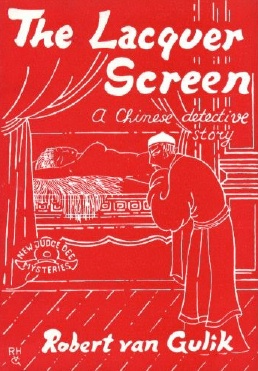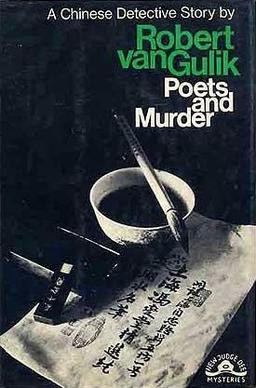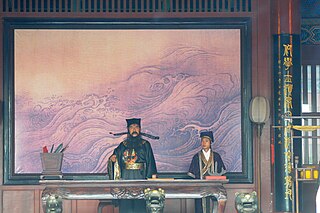Plot introduction
Judge Dee is a recently appointed magistrate to the miserable district of Peng-lai. On the way to town, he meet two ruffians in the woods; Chiao Tai and Ma Joong. They try to rob the judge but instead end up to be his trusted followers.
After arriving to Peng-lai, Judge Dee start the investigation of the murder of his predecessor. The investigation is made more complex by the disappearance of his chief clerk and that of the new bride of a wealthy local shipowner. Meanwhile, a tiger is terrorizing the district, the ghost of the murdered magistrate is stalking members of the court, a prostitute has a secret message for Judge Dee, the body of a murdered monk is found to have been placed in the wrong grave, and there is a serious rumor of smuggling of weapons to Korea.
The Chinese Gold Murders is not the first Judge Dee book that the author wrote, but in the series setting, it is the first story, and shows how the judge met Chiao Tai and Ma Joong. The town of Peng-lai is also the setting for other Judge Dee stories including: The Lacquer Screen , and three of the short stories from Judge Dee at Work .

Judge Dee, or Judge Di, is a semi-fictional character based on the historical figure Di Renjie, county magistrate and statesman of the Tang court. The character appeared in the 18th-century Chinese detective and gong'an crime novel Di Gong An. After Robert van Gulik came across it in an antiquarian book store in Tokyo, he translated the novel into English and then used the style and characters to write his own original Judge Dee historical mystery stories.

Celebrated Cases of Judge Dee, also known as Di Gong An or Dee Goong An, is an 18th-century Chinese gong'an detective novel by an anonymous author, "Buti zhuanren". It is loosely based on the stories of Di Renjie, a county magistrate and statesman of the Tang court, who lived roughly 630–700. Though set in Tang dynasty China, the novel also contains cultural elements from later dynasties. A translated version was released by Robert van Gulik in 1949; van Gulik would go on to write his own series of Judge Dee novels, starting with The Chinese Maze Murders.

Di Renjie, courtesy name Huaiying (懷英), formally Duke Wenhui of Liang (梁文惠公), was a Chinese politician of the Tang and Wu Zhou dynasties, twice serving as chancellor during the reign of Wu Zetian. He was one of the most celebrated officials of Wu Zetian's reign. Di Renjie is depicted in the Wu Shuang Pu by Jin Guliang.

The Chinese Bell Murders is a gong'an historical mystery novel written by Robert van Gulik and set in Imperial China. It is a fiction based on the real character of Judge Dee, a magistrate and statesman of the Tang court, who lived roughly 630–700.

The Chinese Lake Murders is a gong'an historical mystery novel written by Robert van Gulik and set in Imperial China. It is a fiction based on the real character of Judge Dee, a magistrate and statesman of the Tang court, who lived roughly 630–700.

The Chinese Nail Murders is a gong'an detective novel written by Robert van Gulik and set in Imperial China. It is a fiction based on the real character of Judge Dee, a magistrate and statesman of the Tang court, who lived roughly 630–700 BC.

The Chinese Maze Murders is a gong'an historical mystery novel written by Robert van Gulik and set in Imperial China. It is a fiction based on the real character of Judge Dee, a magistrate and statesman of the Tang court, who lived roughly 630–700. However, van Gulik's novel is set not in the Tang, but in the Ming dynasty (1368–1644), with society and customs depicted in the book reflecting this period.

The Haunted Monastery is a gong'an detective novel written by Robert van Gulik and set in Imperial China. It is a fiction based on the real character of Judge Dee, a magistrate and statesman of the Tang court, who lived roughly 630–700.

The Emperors Pearl is a gong'an detective novel written by Robert van Gulik and set in Imperial China. It is a fiction based on the real character of Judge Dee, a magistrate and statesman of the Tang court, who lived roughly 630–700.

The Lacquer Screen is a gong'an detective novel written by Robert van Gulik and set in Imperial China. It is a fiction based on the real character of Judge Dee, a magistrate and statesman of the Tang court, who lived roughly 630–700 AD.

The Red Pavilion is a gong'an detective novel written by Robert van Gulik and set in Imperial China. It is a fiction based on the real character of Judge Dee, a magistrate and statesman of the Tang court, who lived roughly 630–700.

The Monkey and the Tiger book pairs two unrelated short gong'an detective novels written by Robert van Gulik and set in Imperial China. Both stories are fictions based on the real character of Judge Dee, a magistrate and statesman of the Tang court, who lived roughly 630–700.

The Willow Pattern is a gong'an detective novel written by Robert van Gulik and set in Imperial China. It is a fiction based on the real character of Judge Dee, a magistrate and statesman of the Tang court, who lived roughly 630–700.

Murder in Canton is a gong'an detective novel written by Robert van Gulik and set in Imperial China. It is a fiction based on the real character of Judge Dee, a magistrate and statesman of the Tang court, who lived roughly 630–700.

The Phantom of the Temple is a gong'an detective novel written by Robert van Gulik and set in Imperial China. It is a fiction based on the real character of Judge Dee, a magistrate and statesman of the Tang court, who lived roughly 630–700.

Judge Dee at Work is a collection of 8 gong'an detective short stories written by Robert van Gulik and set in Imperial China. It is a fiction based on the real character of Judge Dee, a county magistrate and statesman of the Tang court, who lived roughly 630–700.

Necklace and Calabash is a gong'an detective novel written by Robert van Gulik and set in Imperial China. It is a fiction based on the real character of Judge Dee, a magistrate and statesman of the Tang court, who lived roughly 630–700.

Poets and Murder is a gong'an detective novel written by Robert van Gulik and set in Imperial China. It is a fiction based on the real character of Judge Dee, a magistrate and statesman of the Tang court, who lived roughly 630–700.

Gong'an or crime-case fiction is a subgenre of Chinese crime fiction involving government magistrates who solve criminal cases. Gong'an fiction first appeared in the colloquial stories of Song dynasty. Gong'an fiction was then developed and become one of the most popular fiction styles in Ming and Qing dynasties. The Judge Dee and Judge Bao stories are the best known examples of the genre.
This is the complete list of works by Dutch historical mystery novelist Robert van Gulik.














